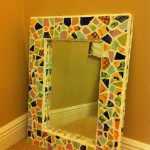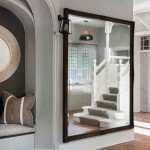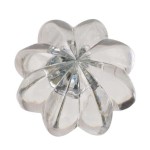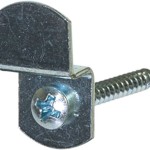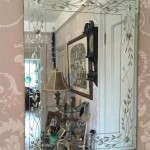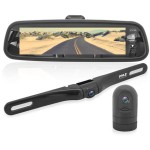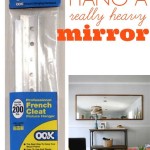How to Safely Remove a Large Bathroom Mirror From the Wall
Removing a large, heavy mirror from a bathroom wall requires careful planning and execution to prevent damage to the mirror, the wall, and most importantly, to avoid personal injury. This process should not be rushed. Proper preparation and the right tools will make the job safer and more efficient.
Gather Necessary Tools and Materials
Before beginning the removal process, collect all the necessary tools and materials. This will streamline the process and minimize interruptions.
- Heavy-duty gloves:
- Safety glasses:
- Drop cloths or old blankets:
- Packing tape:
- Utility knife or putty knife:
- Pry bar or wide putty knife:
- Hammer:
- Suction cups (optional, but recommended for larger mirrors):
- A helper (especially for very large or heavy mirrors):
Prepare the Area
Protecting the surrounding environment is crucial. Bathroom fixtures are susceptible to damage from falling glass shards. Taking preventative measures minimizes potential cleanup and repair costs.
- Clear the area: Remove any items from the vicinity of the mirror that could be damaged.
- Cover the floor and countertops: Use drop cloths or old blankets to protect surfaces from broken glass.
- Cover the sink and any nearby fixtures: This provides an extra layer of protection.
Secure the Mirror
Large mirrors, especially those glued to the wall, present a higher risk of shattering during removal. Securing the mirror's surface helps contain broken pieces and prevents dangerous shards from scattering if breakage occurs.
- Apply packing tape: Create an "X" pattern across the entire surface of the mirror with packing tape. Overlap the strips to provide better support.
- Reinforce vulnerable areas: Add extra layers of tape to the edges and corners of the mirror, where cracks are most likely to initiate.
Determine the Mounting Method
Mirrors can be mounted using various methods, including clips, adhesive, or a combination of both. Understanding the specific mounting method will inform the removal technique.
- Inspect the mirror edges: Look for clips or screws securing the mirror to the wall. These indicate a mechanical fastening system.
- Check for adhesive: If no clips or screws are visible, the mirror is likely adhered to the wall using construction adhesive.
Removing a Mirror Mounted with Clips
Mirrors secured with clips are generally easier to remove than glued mirrors. Care should still be taken to avoid stressing the mirror during detachment.
- Locate the clips: Identify all the clips holding the mirror to the wall.
- Loosen or remove the screws: Use a screwdriver to loosen or remove the screws securing the clips. If the clips are spring-loaded, carefully release the tension mechanism.
- Gently lift the mirror: Once the clips are detached, carefully lift the mirror away from the wall.
Removing a Glued Mirror
Removing a glued mirror requires more effort and presents a greater risk of breakage. Patience and the correct technique are essential for a successful outcome.
- Insert a pry bar or putty knife behind the mirror: Start at a corner or edge and gently work the pry bar or putty knife behind the mirror. Use a thin, flexible blade to minimize damage to the wall.
- Apply gentle pressure: Gradually increase the pressure on the pry bar to separate the mirror from the adhesive. Work slowly and methodically, moving the pry bar along the edges of the mirror.
- Use a hammer if necessary: If the adhesive is particularly strong, gently tap the end of the pry bar with a hammer to help break the bond. Be cautious to avoid striking the mirror directly.
- Cut through the adhesive: As sections of the mirror become loose, use a utility knife or putty knife to cut through the remaining adhesive. This will help prevent the mirror from cracking or breaking.
- Work with a partner: For large, heavy mirrors, have a helper support the mirror as you work to prevent it from falling.
Cleaning the Wall
Once the mirror is removed, the wall may require cleaning to remove any remaining adhesive or residue. The appropriate cleaning method depends on the wall material and the type of adhesive used.
- Scrape off excess adhesive: Use a putty knife or scraper to remove any large chunks of adhesive.
- Apply adhesive remover (if necessary): For stubborn adhesive, use a commercially available adhesive remover following the manufacturer's instructions.
- Clean the wall: Wash the wall with a suitable cleaning solution to remove any remaining residue.

How To Remove A Bathroom Mirror Lowe S

How To Safely And Easily Remove A Large Bathroom Builder Mirror From The Wall Site Title

How To Safely And Easily Remove A Large Bathroom Builder Mirror From The Wall Site Title

How To Safely And Easily Remove A Large Bathroom Builder Mirror From The Wall Site Title

How To Safely And Easily Remove A Large Bathroom Builder Mirror From The Wall Site Title

How To Remove Mirror Off Wallsafely

How To Remove A Mirror Glued The Wall Forbes Home

How To Remove A Frameless Mirror Like Nervous Grandma

How To Remove A Large Mirror That S Glued The Wall Emerging Home

How To Safely And Easily Remove A Large Bathroom Builder Mirror From The Wall Site Title

